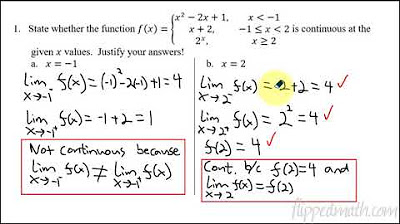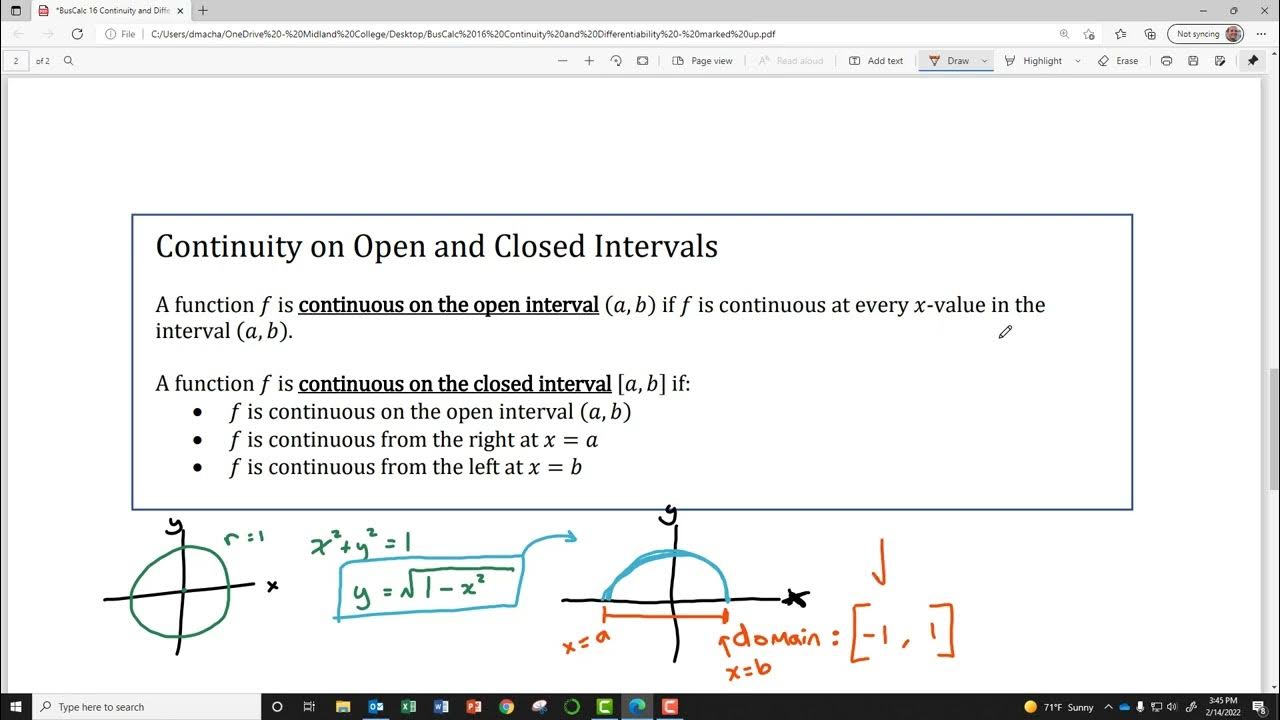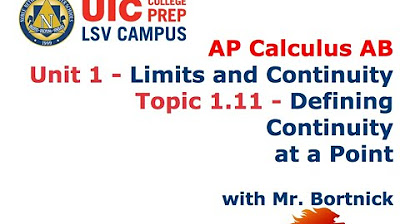Continuity
TLDRThe video script offers an in-depth exploration of the concept of continuity in functions. It begins with an informal definition, describing a continuous function as one that can be traced without interruptions. The script then transitions to a formal definition, highlighting three conditions for a function to be continuous at a point: it must be defined, the limit must exist, and the limit must equal the function value at that point. The lesson delves into various types of functions, such as polynomial, rational, exponential, and square root functions, explaining the conditions under which they are continuous. It also addresses piecewise functions, emphasizing the need to check for continuity at the boundaries between pieces. The script encourages the use of both algebraic methods and graphing tools like Desmos to identify discontinuities and understand the intervals of continuity. The goal is to help learners recognize when a function is discontinuous due to gaps or interruptions in its graph and to appreciate the importance of continuity in mathematical analysis.
Takeaways
- 📐 A function is considered continuous if it can be traced with a pen without any interruptions, such as holes or asymptotes in the graph.
- ✍️ Informally, a function is continuous if it is uninterrupted, and interruptions are features like holes, asymptotes, or gaps in the graph.
- 🔢 Formally, a function is continuous at a point C if it is defined at C, the limit exists as X approaches C, and the limit equals the function value at C.
- 🚫 Discontinuities occur when any of the three conditions for continuity are not met: the function is not defined at C, the limit does not exist, or the limit is not equal to the function value.
- 📈 Polynomial functions are continuous for all values of X because they can handle any input and will produce an output without interruption.
- ⛔ Rational functions can have discontinuities where their denominators equal zero, as this creates a vertical asymptote and excludes the value from the domain.
- 🔁 Exponential functions are continuous for all values of X, similar to polynomials, because they are defined for all real numbers and do not have any undefined points.
- 🚧 Square root functions are continuous over their domain, which includes all X values where the radicand (the number under the square root) is greater than or equal to zero.
- 🧩 Piecewise functions may or may not be continuous, depending on whether the separate pieces connect without interruption across their domains.
- 🔍 To determine continuity of piecewise functions, evaluate the function at the boundaries between the pieces to check for any discontinuities.
- 📊 Graphing functions can help visualize continuity and discontinuities, but it's also important to understand the algebraic principles behind them.
Q & A
What is the informal definition of a continuous function?
-A function is considered continuous if, when traced from left to right, one can draw it without any interruptions such as holes, asymptotes, or gaps in the graph.
What are the three formal conditions required for a function to be continuous at a point?
-For a function to be continuous at a point C, it must be defined at C, the limit as X approaches C must exist, and the limit must be equal to the function value at C.
What is a discontinuity in a function?
-A discontinuity in a function is a point where the function is not continuous, often characterized by a hole, vertical asymptote, or a break in the graph that requires a 'jump' to continue tracing.
Why are polynomial functions always continuous?
-Polynomial functions are always continuous because they are composed of terms that can be evaluated for all real numbers, resulting in a smooth curve with no breaks or undefined points.
What is a common type of discontinuity found in rational functions?
-Rational functions commonly have discontinuities where the denominator is equal to zero, as this results in the function being undefined at those points.
How can one determine the interval of continuity for a function?
-The interval of continuity for a function can be determined by identifying any points of discontinuity and stating that the function is continuous for all points in its domain that do not include these discontinuities.
What is the domain of a square root function?
-The domain of a square root function includes all real numbers that are greater than or equal to zero, as the square root of a negative number is not defined in the set of real numbers.
What is a piecewise function and how does its continuity depend on its pieces?
-A piecewise function is a function composed of different expressions that define the function over different intervals of its domain. Its continuity depends on whether each piece is continuous within its interval and whether the pieces connect smoothly at the endpoints without gaps or jumps.
How can one identify a potential discontinuity in a piecewise function?
-One can identify a potential discontinuity in a piecewise function by evaluating the function at the boundaries where the pieces meet and checking if there is a gap or if the function values do not align from one piece to the next.
What is the interval of continuity for a function that is discontinuous at x = -1?
-The interval of continuity for a function that is discontinuous at x = -1 would be from negative infinity to -1 and from -1 to positive infinity, excluding the point x = -1.
How can graphing calculators or software be used to determine the continuity of a function?
-Graphing calculators or software can be used to visualize the function's graph, allowing one to see if there are any visible breaks, gaps, or asymptotes that would indicate points of discontinuity. The graph can also confirm whether the function appears to be continuous over its domain.
Outlines
😀 Introduction to Continuity in Functions
The video begins with an introduction to the concept of continuity in functions. It explains that a function is considered continuous if its graph can be traced without interruptions, such as holes or asymptotes. The informal definition is contrasted with a formal definition that requires three conditions: the function must be defined at a point, the limit at that point must exist, and the limit must equal the function's value at that point. The importance of these conditions is illustrated through examples of functions with discontinuities.
📈 Discontinuities and Function Behavior
This paragraph delves into the reasons why a function might be discontinuous. It emphasizes that discontinuities occur when the function is not defined at a point, the limit does not exist as one approaches a certain point, or the limit does not equal the function's value at that point. The discussion uses examples to show how these conditions lead to breaks in the graph, which are indicative of discontinuities.
🔍 General Behavior of Continuous Functions
The speaker generalizes the behavior of continuous functions, noting that most functions encountered will be continuous over their domains. Polynomial functions are highlighted as being continuous for all values of X, as they can be any combination of terms involving powers of x. Rational functions, on the other hand, are identified as having discontinuities where their denominators equal zero, leading to vertical asymptotes in their graphs.
📉 Domain Restrictions in Root and Exponential Functions
The video addresses the continuity of exponential and square root functions. Exponential functions are described as being continuous for all X values, similar to polynomials. Square root functions, however, have a limitation; they are only defined for values greater than or equal to zero, which restricts their domain and hence their interval of continuity. The concept of the radicand in a square root function is introduced, and it's explained that it must be non-negative for the function to be defined.
🧩 Continuity in Piecewise Functions
Piecewise functions are discussed in terms of their continuity. It's noted that each piece of a piecewise function can be continuous, but the function as a whole may not be due to potential breaks between pieces. The importance of checking the points where the pieces meet (the boundaries) is emphasized to determine if the function is continuous across the entire domain. The process of evaluating the function at the boundaries to find the intervals of continuity is demonstrated.
🔗 Connecting Pieces and Identifying Discontinuities
The final paragraph focuses on identifying discontinuities in piecewise functions by evaluating the function at the boundaries between different pieces. It's shown that even though individual pieces may be continuous, the function can be discontinuous if the pieces do not connect seamlessly. The use of a graphing calculator or software like Desmos is suggested for visual confirmation of the function's continuity. The video concludes with a reminder that understanding discontinuities is crucial for tracing graphs without interruptions.
📝 Summary and Assignment Advice
The video concludes with a summary of the key points regarding continuity and discontinuities in functions. It advises students to use their understanding of these concepts to tackle assignments effectively. The presenter also encourages students to reach out for help if needed and wishes them well until the next session.
Mindmap
Keywords
💡Continuity
💡Discontinuity
💡Polynomial Functions
💡Rational Functions
💡Exponential Functions
💡Square Root Functions
💡Piecewise Functions
💡Limit
💡Domain
💡Asymptote
💡Graph Tracing
Highlights
A function is considered continuous if it can be traced without any interruptions.
Interruptions in a graph, such as holes or asymptotes, indicate a discontinuity.
For a function to be continuous at a point C, it must be defined at C, the limit as X approaches C must exist, and the limit must equal the function value at C.
Polynomial functions are continuous for all values of X.
Rational functions can have discontinuities where their denominators equal zero.
Exponential functions are continuous for all values of X, similar to polynomials.
Square root functions are continuous only where the radicand is greater than or equal to zero.
Piecewise functions may be discontinuous depending on whether the pieces connect without gaps.
To check for continuity in piecewise functions, evaluate the function at the boundaries of each piece.
Graphing calculators can be used to visualize and confirm the continuity or discontinuity of functions.
Understanding the concept of a discontinuity is crucial for tracing graphs without interruptions.
The interval of continuity for a function can be determined by identifying where it is undefined or where limits do not exist or match the function value.
The domain of a function often dictates its interval of continuity.
For piecewise functions, each piece is assumed continuous, but the overall function may have discontinuities at the transition points.
Discontinuities in piecewise functions occur when the function values at the endpoints of the pieces do not align.
Desmos or similar graphing tools can be used to graph functions and visually inspect for continuity.
When analyzing piecewise functions, it's important to check the points where the function definition changes for potential discontinuities.
Continuous functions have no gaps or jumps in their graph, which is a key concept in calculus and function analysis.
Transcripts
5.0 / 5 (0 votes)
Thanks for rating:





